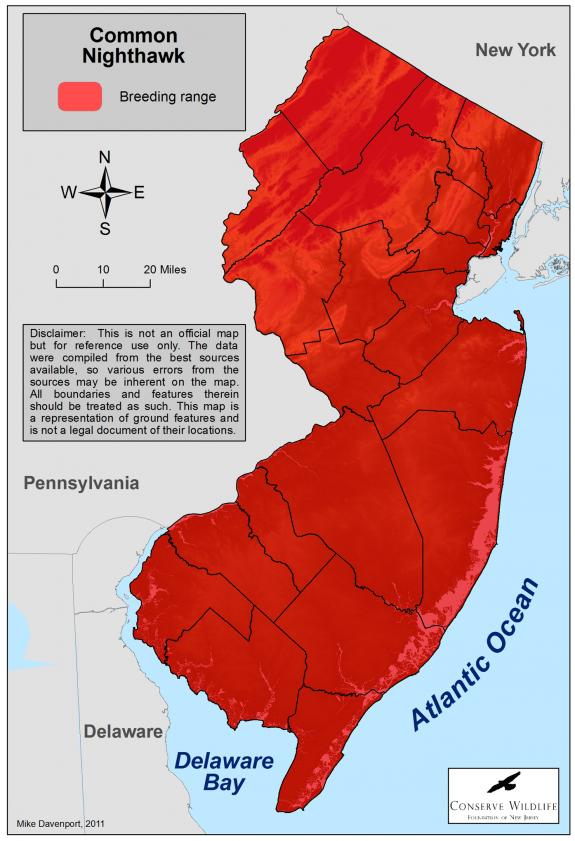Chordeiles minor
Type: bird
Status: special concern
Species Guide
Common nighthawk
Chordeiles minor
Species Type: bird
Conservation Status: special concern
IDENTIFICATION
The common nighthawk is within a Family of birds known as Caprimulgidae or “goatsuckers”. These largely nocturnal birds were called goatsuckers under the mistaken belief that they fed by suckling on goats during the night. Like all goatsuckers, the common nighthawk is cryptically camouflaged and has a large head with large eyes and a tiny bill. It is largely gray-brown in color with a white throat.
This species tends to be more active at twilight (crepuscular) than other goatsuckers and they are usually observed in flight – they are very difficult to see when they are perched since they blend-in so well with their surroundings. In flight, they have pointed wings with white bars across the center of each wing. Their white throat may also be visible during flight and they have a notched tail. They fly with easy strokes but frequently “change gear”, flying with quicker, more erratic strokes.
Like other goatsuckers, the common nighthawk is often heard at night. Their call is a nasal peent or pee-ik.

Distribution & Habitat
The breeding range of the common nighthawk covers most of Canada outside of the Arctic, tundra-covered expanse in the north, as well as all of the U.S. lower 48 states, and central Mexico. They are year-round residents in the West Indies. They winter in northern and central South America.
Habitat for this species includes open coniferous forest, forest clearings, grasslands, fields, and open areas within urban areas. They nest on bare ground with no nesting material, usually in an open area.
Diet
Common nighthawks feed on insects which they catch while flying either during the day (usually early in the morning or late in the evening) or at night. Their prey consists of flying insects such as moths, mosquitoes, flies, and beetles.
Life Cycle
The common nighthawk is typically a solitary species but will occasionally forage or migrate in loose flocks. The breeding season in New Jersey is between mid-May and mid-August. Two eggs are typically laid and are incubated by the female. The eggs hatch after about 19 days. Their nestlings are semi-precocial and are tended to by both parents which feed them regurgitated insects. The young are completely independent at about 30 days after hatching. This species has a single brood each breeding season.
Current Threats, Status, and Conservation
The common nighthawk is listed in New Jersey as a Species of Special Concern (not yet endangered or threatened but possibly on its way). Although they have a large range and a presumed large population across that range, survey data suggests a long-term, slow decline. Potential causes may be loss of habitat, nest predation, and pesticide use.
This species is somewhat difficult to survey for since they are crepuscular and camouflaged. Further survey effort will be necessary in order to determine the species’ distribution and population trend in New Jersey.
References
Text written by Michael J. Davenport in 2011.
Scientific Classification
- Kingdom: Animalia
- Phylum: Chordata
- Class: Aves
- Order: Caprimulgiformes
- Family: Caprimulgidae
- Genus: Chordeiles
- Species: C. minor